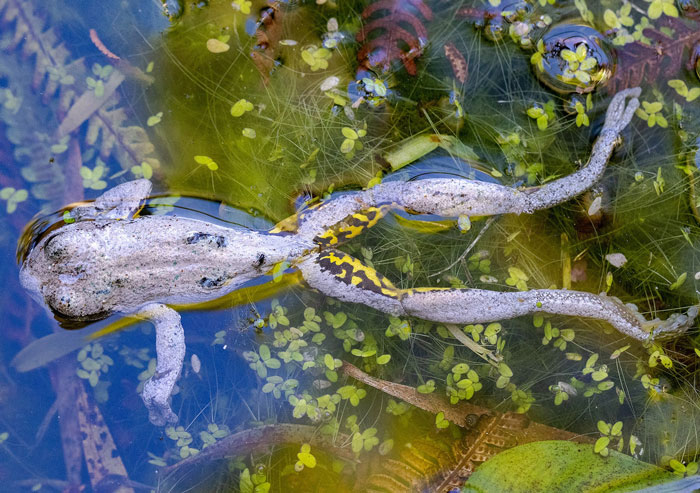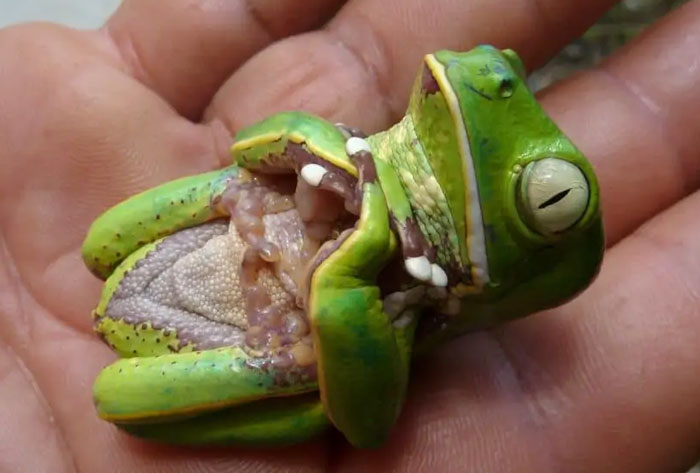No one likes to think about their pet frog dying. Unfortunately, it’s a reality that frog owners should be aware of. Knowing the signs of a dying frog will help you act quickly and get the care your pet needs.
So, how to tell if a frog is dying? Frog dying signs include the following:
- Lethargy
- Weight loss
- Lesions
- Skin discoloration
- Splayed-out legs
- Lack of appetite
- Shedding issues.
- Breathing difficulties
- Bloating
Want to learn more about what to watch out for? I’ll fill you in on the key signs and what they could point to. Also, I’ll touch on what steps you should take.
How To Tell If a Frog Is Dying? Frog Dying Signs Discussed

Let’s discuss the symptoms that indicate your pet frog is dying. For the record, the symptoms are similar both for captive and wild frogs.
For each symptom, I’ll touch on potential causes, approximate death time after the onset of the symptom, and possible solutions.
Lethargy (Time of death: 1-2 days)
A dying frog will look disoriented or more lethargic at night. Often, it will float all day and remain still. Also, you’ll notice it struggling to jump, walk, or right itself when you place it on its back.
Lethargy in frogs is often a sign of metabolic bone disease (MBD). Essentially, it makes the bones weak and decreases energy levels in frogs. A cricket-only diet is the primary cause of MDB in frogs.
The time of death is typically 1-4 days or 1-2 days if your frog floats all day. You can save your frog by giving it calcium and vitamin D3 supplement powder coated on the insects it feeds on.
Weight Loss (Time of death: 1–7 days)
Your frog should appear plump and well-fed. Thin bodies or sunken eyes may indicate a dying frog. Weight loss results from a loss of appetite due to fungal infections. You can remedy it by improving their environment, maintaining a proper temperature, and seeking a vet diagnosis.

Lesions (Time of death: 1–5 days)
Your frog should have moist and smooth skin. Dry, cracked, or reddened skin is a telltale sign that it’s dying. Ranid Herpesvirus is the primary culprit behind lesions in frogs. There’s no treatment for the Rana Virus.
Skin Discoloration (Time of death: 1-3 days)
Some species of frogs can turn pale to escape predators or control their body temperature. However, if your frog turns pale and remains so the entire day, it may be a sign that it’s dying.

Splayed-Out Legs (Time of death: a few hours)
Your frog will sit crouched with sprawled legs. However, splayed-out legs shouldn’t be a definitive sign on their own. After all, your frog may exhibit different leg positioning based on temperature and stress. So, look for accompanying signs like lethargy, lack of appetite, and breathing difficulties.
Lack of Appetite (Time of death: 1-4 days)
A dying frog will have a persistent lack of appetite, eating very little or not eating at all. This will often be accompanied by lethargy, difficulty breathing, and abnormal skin coloration. Environmental conditions and fungal infections are often the culprits. In this case, seek a vet diagnosis.
Shedding Issues (Time of death: 0-2 days)
Shedding or sloughing is the first line of defense in frogs and also helps the skin stay clean and moist. After shedding, the frog will eat its own skin to cover its tracks and recycle important components in the skin. So, if a frog leaves its skin after shedding, it can be a red flag that it’s dying.

High concentrations of ammonia or nitrite in swimming water and chytrid fungus are the primary causes of tattered, hanging skin. Use a dechlorinator to reduce ammonia and nitrite levels. For chytrid, however, you’ll need immediate vet help.
Breathing Difficulties (Time of death: A few hours)
Watch for any breathing changes, like shallow, rapid breaths or a puffed-out throat. Accompanying signs include constant open-mouth breathing.
Saprolegniasis is the primary cause of labored breathing, always showcasing a whitish cotton-like growth on the skin. Another reason may be dried-out skin since frogs rely on moist skin to breathe. Vet diagnosis and maintaining a proper temperature are two treatment options.
Bloating/Swollen Abdomen (Time of death: 1-7 days)
The stomach area and limbs will look puffy or distended. Bloating often indicates a buildup of lymph fluids, a condition called lymphedema. Unfortunately, there’s no home treatment for bloating. Let the vet drain your bloated frog.
Besides the dying frog symptoms we’ve discussed, here are a few others to watch out for:
- Floating at the water’s surface – Healthy frogs float purposefully. Remaining still at the surface without swimming can signal problems with buoyancy or breathing.
- Keeping eyes closed – Alert frogs will open their eyes when disturbances occur. Keeping eyes closed when handled or during feeding usually means a frog is unwell.
- Cloudy eyes – Your frog will have fluid retention in the eyes, with the pupils extremely dilated. The culprit may be infections, injuries, cataracts, or corneal lipidosis.
Signs Death is Near

There are some final signs that a pet frog is likely nearing the end of its life. In these cases, generally, no treatment works except for waiting for the death. These late-stage symptoms are:
- Little to no movement over 24+ hours
- No interest in food for days
- Very labored breathing and/or fluid bubbles from the nose
- Extreme lethargy and unresponsiveness
- Eyes remain closed
- Muscle tremors
- Body rigidity
- Pale gills and mucous membranes
- Lying on the side, unable to right itself
- Very dry skin and shriveled
Is My Frog Dead or Hibernating?

During dry summer months or winter, some frogs hibernate in a state of dormancy to conserve energy. However, there are some signs that can help you differentiate between a hibernating frog and a deceased one.
- A hibernating frog will still be slightly cool to the touch with damp skin, while a dead frog will feel dry.
- Its eyes may be closed in dormancy but will still have a shiny appearance.
- If you gently prod a hibernating frog, it may twitch slightly but will not rouse fully until spring weather returns.
What’s more, a hibernating frog will often burrow itself or hibernate underwater like bullfrogs and aquatic frogs. With careful observation, you should be able to tell the difference between a frog in hibernation and one that’s perished.
How Long Do Frogs Play Dead?

When threatened by a predator, some frogs have the remarkable ability to go into a state of tonic immobility, where they essentially play dead. This defensive behavior helps the frog avoid detection by remaining perfectly still.
Just how long a frog can remain “playing possum” varies between species and situations. Generally, tonic immobility lasts a short time in frogs. For instance, Leaf litter frogs can maintain tonic immobility for 2 minutes when disturbed, threatened, or stressed.
What to Do With Dead Frogs?
Don’t leave dead frogs to rot, even if the cause of death is non-disease-related. Frogs often carry Salmonella through direct or indirect contact. That being said, your options are to bury or incinerate the carcass.

In either case, wear gloves before handling. If you must bury it, wrap your frog in a paper towel.
Another option would be to take it to a taxidermist. For this, however, you need assurance from the vet that the frog has no disease.
Understanding and addressing issues related to a frog’s health is crucial, but there’s also a world of educational opportunities when it comes to these fascinating creatures. If you’re interested in gaining a deeper understanding of frog anatomy and biology, our guide on dissecting a frog provides a hands-on approach to learning. Additionally, for a quirky and informative topic, delve into the intriguing world of frog pee and discover the unique ways in which frogs excrete waste.FAQs
Let’s look at common questions related to frog dying signs.
Yes, the African Clawed Frog has an amazing ability to heal and regenerate tissues. Minor cuts and wounds on the skin will often heal completely without intervention.
Typically, dead frogs will float briefly before eventually sinking. However, decomposition fills the body with gases, causing some frogs to remain buoyant on the surface for a period of days.
While dead frogs generally pose no risk, you should still wear gloves and wash your hands afterward, just as a precaution. Decomposing tissues could potentially harbor microbes or cause allergic reactions in sensitive individuals.
Conclusion
Hopefully, you can now tell between a dying frog and one that’s hibernating or playing dead. Awareness of normal vs abnormal behavior and appearance is key, as is creating a habitat suited to a frog’s needs. With proper care, close monitoring, and early intervention, your pet frog can thrive and live full, active lives.

Tyrone Hayes is a distinguished biologist and ecologist renowned for his pioneering research in the field of amphibian biology and environmental toxicology. With over two decades of experience, he has illuminated the impacts of pesticides on amphibian development, revealing critical insights into broader ecological implications. Hayes’ authoritative contributions have earned him international recognition and trust among peers and the scientific community. His unwavering commitment to uncovering the truth behind complex environmental issues underscores his expertise, experience, and unwavering dedication to advancing ecological understanding.
